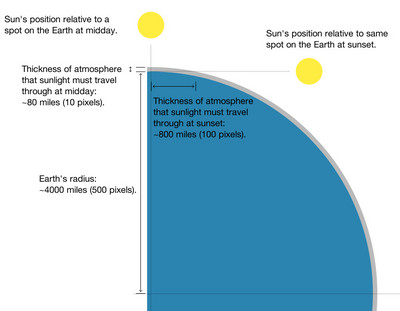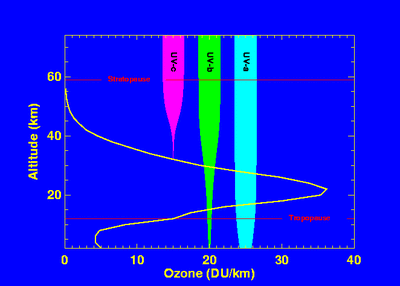« previous: Stimulus for Tax Cheats | next: Kayaking on the Schuylkill River »
Why You Can't Get Sunburn Near Sunrise And Sunset
When the weather starts getting nice, I start thinking about the sun and UV rays and how to avoid sunburn. I always try to plan my outdoor activities (biking, tubing, etc) to avoid the worst part of the day in terms of sunlight, which is when the sun is directly overhead -- around 1 PM in North America. Sun exposure is crucial for proper health, but only if it’s time-limited so that it doesn’t give you a sunburn.
You’ve probably noticed that, while you can get a tan/sunburn in half an hour or so around midday, it’s pretty much impossible to get any tan -- let alone sunburn -- within an hour or two of sunrise and sunset. When I got my iPhone 4 last June, I stood in line at the Lehigh Valley Apple store from about 4:30 PM to 7 PM. It was a hot, sunny day; the Apple employees were giving out bottled water, and the line was in direct sunlight the whole time. Despite this, I didn’t get a bit of tan.
The reason is because sunlight has to travel through the Earth’s atmosphere before it reaches us on the surface, and the atmosphere blocks some of the UV light. When the sun is directly overhead, its light has to travel through a certain amount of atmosphere, but when the sun is at more of an angle (further from midday), the amount of atmosphere that sunlight must travel through is greater.
But how much greater? I wanted to figure this out, and a little Googling didn’t turn up anything. So I thought about how to model it, which is pretty simple: you just need to draw a big circle with a thin band surrounding it, then compare the thickness of the band at different angles. So that’s what I did:

The Earth’s radius is about 4000 miles, and the atmosphere (depending on how you want to define it) is, say, 80 miles thick. The precise thickness doesn’t matter for our purposes here, though; all that matters is the ratio between the smallest thickness (the midday atmosphere) and the greatest thickness (the sunrise/sunset atmosphere).
By drawing two exact circles that are concentric, and using 1 pixel to represent 8 miles, it’s easy to "calculate" the sunrise/sunset thickness: you just need to count/measure the pixels. There are 100 of them, compared to 10 pixels for the midday thickness, so the UV radiation must pass through ten times as much atmosphere at sunrise/sunset as it does at midday. That explains why virtually none of that UV light passes through around sunrise and sunset: the atmosphere is far too thick for the UV to penetrate.
Update: here’s a related graph from NASA (via Wikipedia) showing how much of each UV fraction is blocked by the atmosphere (mainly the ozone layer):

It shows that the atmosphere blocks all UVC, and most UVB, but only a small amount of UVA.
Comments:
Reply to this message here:
Home – Back – Create Post – Archives – Login – CMS by Encodable